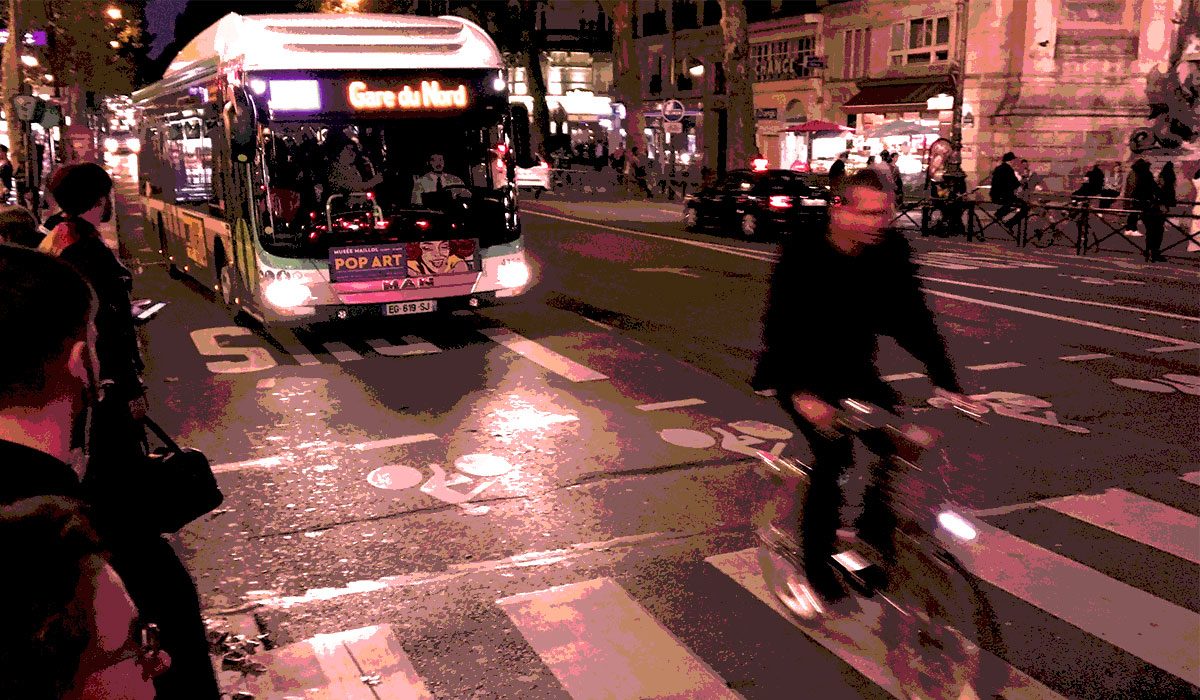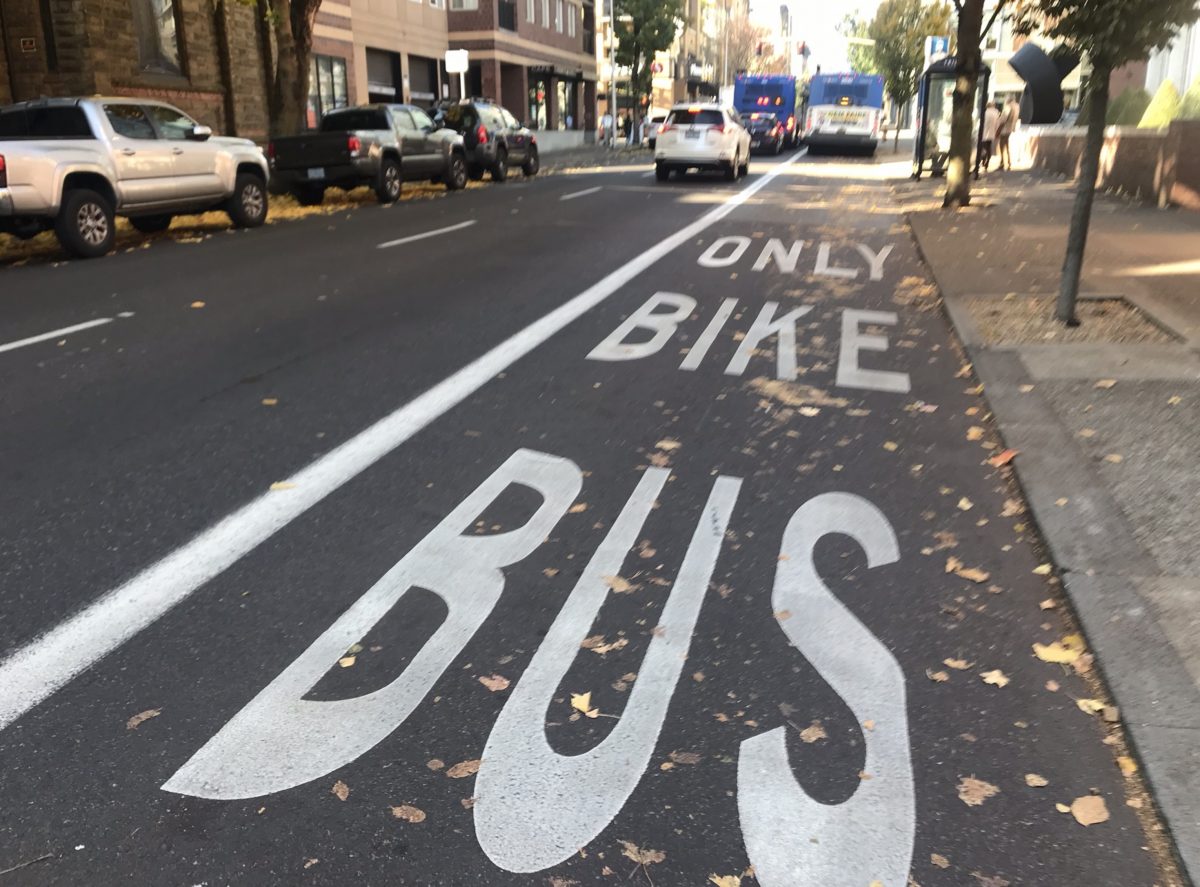
(Photo: J. Maus/BikePortland)
It’s time for bike, e-mobility, and transit riders to team up against the real enemy. With the Rose Lane project underway and e-bikes on the horizon, Portland should consider more carfree lanes.
– A guest opinion from Portland resident Henry Miller
“I am a lover of our bike lanes and our bike share system, but holy-moly we ain’t seen nothing yet.”
It would have been easy to start panicking when I hopped on my first e-assist rental bike. The buttons were sticky, the screen was difficult to decipher, cars were buzzing by, the cobblestones were slick from rain and, oh yeah, I was four thousand miles away from Portland’s familiar bike lanes.
Fortunately, and I was not prepared for this, biking across Paris is a dazzling dream made up of plentiful bike lanes, famous architecture, and soft-spoken French automobiles. But best of all, was riding the Parisian bike share system’s e-bike in the city’s many shared bike/transit/taxi lanes.
As an employee of Biketown, I know our bike system. I know how to zip from northeast Mississippi to the South Waterfront while almost never rolling outside a designated bike lane. I am a lover of our bike lanes and our bike share system, but holy-moly we ain’t seen nothing yet.

(Photo: J. Maus/BikePortland)
It’s not hard to imagine the benefits of an e-bike — no distance is too far, no hill to steep, and no sweaty armpits when you get to your destination. Yet having superbikes, which are expected to come to Biketown next year, only addresses half of what makes a bike system great. The other half is bike infrastructure that makes biking (and all micro-mobility vehicles for that matter) as appealing as driving. Paris accomplishes the second feat by dedicating entire lanes on crucial streets across the city to bus, taxi (but not Lyft or Uber), bike, and e-mobility (scooters mostly) riders.
At first glance, that did not seem like a good idea. I was terrified of ending up in front of a flustered cabbie or, infinitely worse, under the wheel of a bus. Then I realized something as I darted from landmark to landmark and commercial street to neighborhood alley: I wasn’t sharing the lane with bus drivers because we are the same size or same speed, but because people in cars outnumber us. I wasn’t using bike infrastructure. I was using carfree infrastructure. This is the perspective shift that could allow Portland to provide better transit, better bike, and better e-mobility systems at the same time.
Advertisement
When treated individually, dedicating streets to buses or bikes is challenging from both traffic engineering and political standpoints. When the Portland Bureau of Transportation tried to improve the Clinton Street by diverting drivers off of it, the controversial result was more drivers using adjacent streets. And I’ve heard many complaints about how PBOT has made it harder to drive without providing adequate alternatives.
This lack of an alternative might explain why TriMet ridership has dropped even as Portland’s roadways are dealing with L.A. levels of congestion. Hey, would you rather be stuck in traffic on a crowded bus, or in your own car?
PBOT is attempting to fix that problem with their groundbreaking Rose Lane Project. This project is likely to get pushback from the same people who point out that, at least for now, bus lanes will only be used by a sliver of Portland’s commuters (compared to drive-aloners). It’s a fair argument, and the fastest way to weaken it is to put more people — not just bus riders — in those lanes.
By creating a lane that serves bicycle, bus, e-scooter, and e-bike users, we combine the interests of more commuters and provide a stronger justification for “taking a lane away” from drivers. We also create carfree lanes that can be implemented on some of our retail and commercial corridors, giving many more people a way to access popular destinations where neighborhood greenways come up short.
Advertisement


But would these carfree mixed lanes feel safe? If they are anything like what is in Paris, absolutely.
“For the most part, biking along a transit lane in Paris means having the road to yourself.”
For the most part, biking along a transit lane in Paris means having the road to yourself. At their fastest, most buses don’t arrive at a station closer than 8-10 minutes apart. Spatially, those minutes contain hundreds of yards of unoccupied street, where a bicycle user can move at their own speed and enjoy a ten-foot-wide bike lane. These gaps made it feel much safer to pass or be passed by scooter users and other bike riders, as well as cab drivers.
When bus drivers do come along, their vehicles are big, slow, and predictable — even with their own lane. This makes them easy to spot and navigate around, at least compared to the kinds of drivers I’ve run into on the Clinton Street greenway – which includes everyone from heavy-duty pickup truck drivers to teens in sports cars, to SUV driving soccer moms.
Portland already has small segments of carfree lanes where bus and bike riders mix. We now have a golden opportunity with the Rose Lane Project to take things to the next level.
Of course, these carfree lanes won’t stay safe and sane forever. Eventually the high volume of people on bikes, scooters, and who knows what else maneuvering around articulated buses on streets like Broadway and Hawthorne will be enough to create serious safety hazards. No big deal. When that happens, Portland’s carfree lanes could quickly absorb a second lane with a few stripes of paint — a process that will be so much easier when nobody wants to drive anymore because our transit and micro-mobility systems are that much better at getting Portlanders where we want to go.
— Henry Miller (website)
— Get our headlines delivered to your inbox.
— Support this independent community media outlet with a one-time contribution or monthly subscription.


